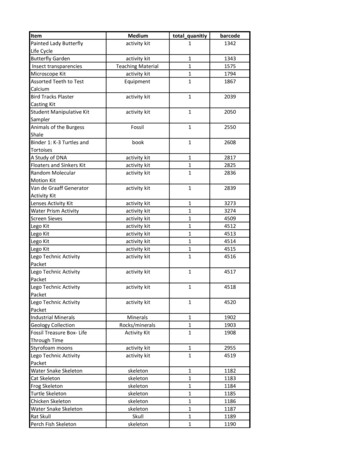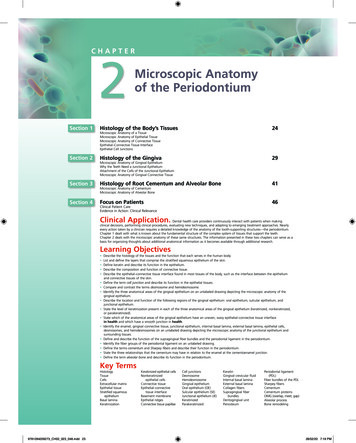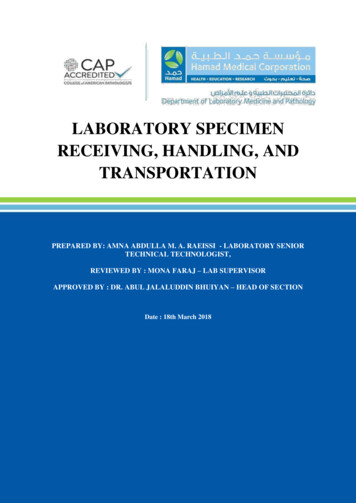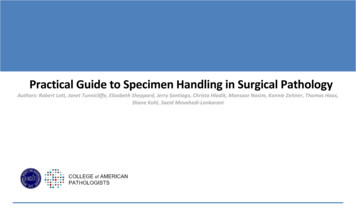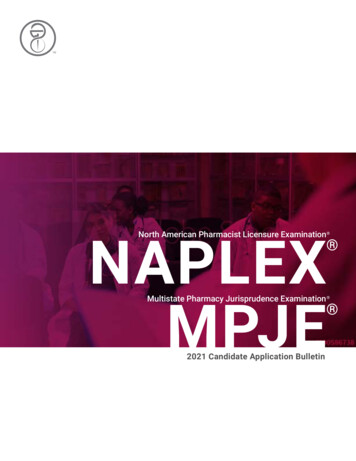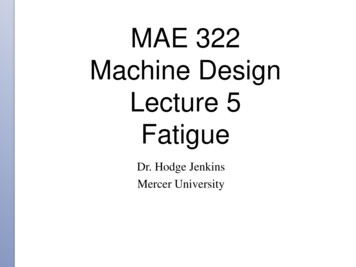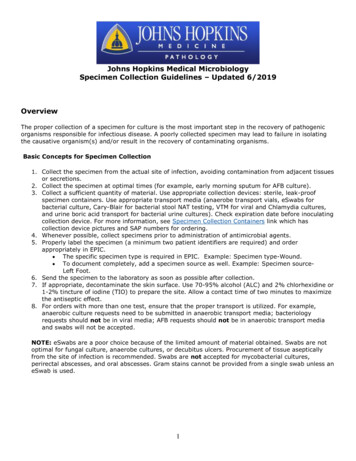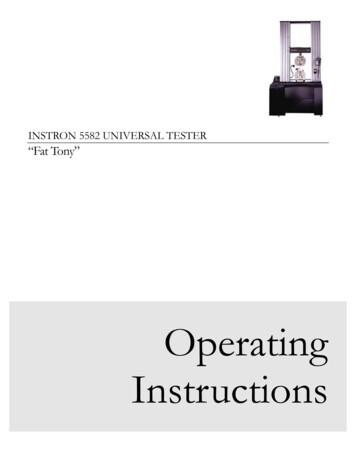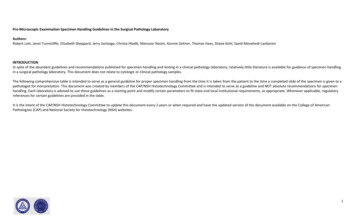
Transcription
Pre-Microscopic Examination Specimen Handling Guidelines in the Surgical Pathology LaboratoryAuthors:Robert Lott, Janet Tunnicliffe, Elizabeth Sheppard, Jerry Santiago, Christa Hladik, Mansoor Nasim, Konnie Zeitner, Thomas Haas, Shane Kohl, Saeid Movahedi-LankaraniINTRODUCTIONIn spite of the abundant guidelines and recommendations published for specimen handling and testing in a clinical pathology laboratory, relatively little literature is available for guidance of specimen handlingin a surgical pathology laboratory. This document does not relate to cytologic or clinical pathology samples.The following comprehensive table is intended to serve as a general guideline for proper specimen handling from the time it is taken from the patient to the time a completed slide of the specimen is given to apathologist for interpretation. This document was created by members of the CAP/NSH Histotechnology Committee and is intended to serve as a guideline and NOT absolute recommendations for specimenhandling. Each laboratory is advised to use these guidelines as a starting point and modify certain parameters to fit state and local institutional requirements, as appropriate. Whenever applicable, regulatoryreferences for certain guidelines are provided in the table.It is the intent of the CAP/NSH Histotechnology Committee to update this document every 2 years or when required and have the updated version of the document available on the College of AmericanPathologists (CAP) and National Society for Histotechnology (NSH) websites.1
PART II. SPECIMEN COLLECTION and HANDLINGGuideline SectionCollection and HandlingA. Patient IdentificationStatementCAP Checklist Patient is to be identified in a manner that respects patient privacy with respect totheir medical records and medical data.College of American Pathologists LaboratoryGeneral Checklist, GEN.40000 - SpecimenCollection Manual Patient's identity must be verified at the time of specimen collection.College of American Pathologists LaboratoryGeneral Checklist, GEN.40490 - PatientIdentification At least two acceptable unique identifiers are required for patient identification:o Full nameHealth Insurance and Portability andAccountability Act (HIPAA).o Assigned identification number e.g. health record / master index numberClinical Laboratory Standards InstituteCLSI - GP33A, Accuracy in Patient andSample Identification; 2011: Vol 30No7.o Date of birtho Photo on government issued or other photo ID card, such as driver's licenceInternational Standard ISO 15189:2007- Medical Laboratories; section 16 - Preexamination.o Other specific personal identifiersCollection and HandlingB. Proper LabellingReference Specimen label must contain at least two unique identifiers:oFull patient nameoAssigned identification number e.g. health record / master index numberoDate of BirthCollege of American Pathologists LaboratoryGeneral Checklist, GEN 40000 - SpecimenCollection Manual Customizable label elements – additional identifiers that are acceptable:oPatient genderoAccession or requisition numberoOrdering physicianoSource of specimen ( e.g. skin)oSite of specimen ( e.g. left side of chest)College of American Pathologists LaboratoryGeneral Checklist, GEN. 40100 - SpecimenCollection Manual ElementsCollege of American Pathologists LaboratoryGeneral Checklist, GEN. 40491 - SpecimenLabelling2
Collection and HandlingB. Proper Labellingi. Barcoding and/orRadio FrequencyIdentification(RFID) Standardized format for label information should be implemented.oLast name, first nameoDate of Birth – DD –MMM- YYYY i.e. 12 MAR 1968oGender M, F, U ( unknown), T ( Transgender), H ( hermaphrodite) Written documentation developed for the correct positioning of the label on thecollection container.oDo not attach label to the container lid (in whole or part)oDo not overlap label resulting in patient data being coveredCollege of American Pathologists LaboratoryGeneral Checklist, ANP.11500 - SpecimenIdentity Written documentation for the correction of labelling errors – to be followed whenspecimens cannot be replacedCollege of American Pathologists LaboratoryGeneral Checklist, GEN.40492 – SpecimenLabel Correction All subsequent labelling of patient samples (blocks and slides) must follow sameunique indentifying process.College of American Pathologists LaboratoryGeneral Checklist, GEN.40825 - SpecimenID Submitted slides may be labeled with a single identifier but two are preferred. All parameters used for standard specimen labelling are to be followed. The unique specimen bar code or RFID label must be consistent across allapplications: specimen container, requisition label, cassette and slide labels. Barcode and RIFD specifications within a failure rate established by your facilityfor patient care. Barcode label stock or RFID chip validated to withstand chemicals andprocessing used for anatomic pathology specimens. Bar coding and/or RFID documentation must be validities and maintained. Automatic identification scanning equipment is validated for accuracy andresistant to chemicals used for anatomic pathology handing.Clinical Laboratory Standards InstituteCSLI – Auto12-A Specimen Labels:Content and Location, Fonts and LabelOrientation: 2011: Vol. 31 No7.Clinical Laboratory Standards InstituteCSLI – Auto12-A Specimen Labels:Content and Location, Fonts and LabelOrientation: 2011: Vol. 31 No7.College of American Pathologists LaboratoryGeneral Checklist, GEN. 40491 - SpecimenLabellingCollege of American Pathologists LaboratoryGeneral Checklist, GEN.40825 - SpecimenIDZarbo RJ, Tuthill JM, D’Angelo R, et al.The Henry Ford Production System:reduction of surgical pathology inprocess misidentification defects by barcode-specified work processstandardization. Am J Clin Pathol. 2009;131:469-477.Clinical Laboratory Standards InstituteCSLI – Auto02-A2 LaboratoryAutomation: Bar Codes for SpecimenContainer Identification: 2006: Vol. 25No 29.3
Collection and HandlingC. Transport Mediai. No media / salineCollection and HandlingC. Transport Mediaii. Different fixatives If used for specimen chain of custody tracking, the barcode or RFID trackingsystem must have intelligent location capabilities.Collection, handling and submission procedures must be made available to allhealth care workers involved in the collection, labelling, submission and transportof specimens to the pathology laboratory. All specimens must be placed in leak proof container. To avoid drying of tissues:owrap solid tissue masses ( i.e. lymph node or breast lump) in salinedampened gauze prior to placement in labelled containeroadd a small volume of saline to tissue with insufficient naturally occurringfluids (i.e. conceptus for embryopathology/genetic studies)College of American Pathologists LaboratoryGeneral Checklist, GEN.40000 - SpecimenCollection ManualClinical Laboratory Standards InstituteCLSI – GP33A, Accuracy in Patient andSample Identification; 2011: Vol 30No7.College of American Pathologists LaboratoryGeneral Checklist, GEN.40100 - SpecimenCollection Manual ElementsClinical Laboratory Standards InstituteCLSI - LIS09A, Standard guideline forcoordination of clinical laboratoryservices within electronic health recordenvironment and networkedarchitectures; 2003: Vol. 23 No 15.College of American Pathologists LaboratoryGeneral Checklist, GEN.40125 - ReferralLaboratory Specimen HandlingInternational Standard ISO 15189:2007- Medical Laboratories; section 16 Preexamination.College of American Pathologists LaboratoryGeneral Checklist, GEN.40535 - SpecimenTransport QM Specimens must be transported to the laboratory immediately after collection. Specimens that cannot be immediately transferred must be refrigerated untiltransferred to the Pathology laboratory. Specimens transferred from distant referral site to Pathology lab should beshipped under temperature controlled conditions to avoid over heating or freezing. All specimens must be properly packaged and labelled, indicating materials to betransported prior to shipping to a centralized or reference laboratory.College of American Pathologists LaboratoryGeneral Checklist, GEN.40535 - SpecimenTracking QM Collection, handling and submission procedures must be made available to allhealth care workers involved in the collection, labelling, submission and transportof Specimens to the pathology laboratory.College of American Pathologists LaboratoryGeneral Checklist, GEN.40000 - SpecimenCollection ManualCollege of American Pathologists LaboratoryGeneral Checklist, GEN.40511 - SpecimenTracking/LabellingBancroft J, Gamble M. Theory andthPractice of Histological Techniques, 6ed. New York, NY: Churchill Livingston;2008Carson F, Hladik C. Histotechnology ArdSelf- Instructional Text, 3 ed. Chicago,IL: ASCP Press; 2009Clinical Laboratory Standards InstituteCLSI - LIS09A, Standard guideline forcoordination of clinical laboratoryservices within electronic health recordenvironment and networkedarchitectures; 2003: Vol. 23 No 15.4
All specimens must be placed in leak proof container. Specimens must be placed in appropriate fixative as specified incollection/handling and submission procedure.Bancroft J, Gamble M. Theory andthPractice of Histological Techniques, 6ed. New York, NY: Churchill Livingston;2008 Volume of fixative to tissue ratio must be included in the collection/handling andsubmission procedures. i.e. 10% neutral buffered formalin volume should be 20times the volume of the specimen.Carson F, Hladik C. Histotechnology ArdSelf- Instructional Text, 3 ed. Chicago,IL: ASCP Press; 2009 MSDS must be made available to all staff handling fixatives.Material Safety Data SheetsCollege of American Pathologists LaboratoryGeneral Checklist, GEN.40100 - SpecimenCollection Manual ElementsInternational Standard ISO 15189:2007Medical Laboratories; section 16 Preexamination.Clinical Laboratory Standards InstituteCLSI – GP 17-A2, Clinical LaboratorySafety, 3rd edition; 2012: Vol 32 No 9. All specimen containers containing fixatives must have appropriate OSHAChemical labels attached.College of American Pathologists LaboratoryGeneral Checklist, GEN.40125 - ReferralLaboratory Specimen Handling Specimens transferred from distant referral site to Pathology lab should beshipped under temperature controlled conditions to avoid over heating or freezing.College of American Pathologists LaboratoryGeneral Checklist, GEN.40511 - SpecimenTracking/LabellingSpecimens containers should be shipped following appropriate regulations for theshipping and handling of formalin i.e. hard sided container with absorbent packingmaterial.College of American Pathologists LaboratoryGeneral Checklist, GEN.40535 - SpecimenTransport QM mlSPECIMEN COLLECTION & HANDLING - REQUISITIONGuideline SectionCollection and HandlingD. Completion ofrequisitioni. Patient identifiersOccupational Health and SafetyAdministration. Occupational Safety &Health Standards 1910.1200 toxic andHazardous Substances.StatementCAP Checklist Written procedures on how to properly complete a pathology requisition must bemade available to all health care workers involved in the collection, labelling,submission and transport of specimens to the pathology laboratory.College of American Pathologists LaboratoryGeneral Checklist , GEN.40700 Requisitions Written or electronic request for patient testing from authorized person.College of American Pathologists LaboratoryGeneral Checklist, GEN.40930 - AuthorizedRequestorReference5
Required patient identifiers to be included on the requisition / test order:o Patient’s nameo Unique identifier i.e. health record or master index numbero Date of Birtho SexCollege of American Pathologists LaboratoryGeneral Checklist, GEN.40750 - RequisitionElementsClinical Laboratory Standards InstituteCLSI - GP33A, Accuracy in Patient andSample Identification; 2011: Vol 30No7.International Standard ISO 15189:2007- Medical Laboratories; section 16 - Preexamination.Collection and HandlingD. Completion ofrequisitionii. Specimenname/type/site Written or electronic request for patient testing to include:o Patient identifiers as listed aboveo Name and address or other suitable identifiers of the authorized personrequesting the testo Name and address or other suitable identifier for the individual responsible forreceiving the test resultso Name and address of the laboratory submitting the specimenClinical Laboratory Standards InstituteCLSI - GP33A, Accuracy in Patient andSample Identification; 2011: Vol 30No7.College of American Pathologists LaboratoryGeneral Checklist, GEN.40930 - AuthorizedRequestorInternational Standard ISO 15189:2007- Medical Laboratories; section 16 - Preexamination.College of American Pathologists LaboratoryGeneral Checklist, GEN.40750 - RequisitionElementso Test and or tests to be performedo Specimen site – if more than one specimen is collected during a singleprocedure; each specimen should be individually identified by anatomic siteand or specimen typeo Date and time of procedure or specimen collectionCollege of American Pathologists LaboratoryGeneral Checklist, GEN.40900 - SpecimenDate Receivedo Date specimen receivedCollection and HandlingD. Completion ofrequisitioniii. Pertinent clinicalhistory Health Insurance and Portability andAccountability Act (HIPAA).Written or electronic request for patient testing to include:o Clinical history – any additional information relevant or necessary for aspecific test to ensure accurate and timely testing and reporting of results,College of American Pathologists LaboratoryGeneral Checklist, GEN.40750 - RequisitionElementsClinical Laboratory Standards InstituteCLSI - GP33A, Accuracy in Patient and6
including interpretation if required.Sample Identification; 2011: Vol 30No7.International Standard ISO 15189:2007- Medical Laboratories; section 16 - Preexamination.Collection and HandlingD. Completion ofrequisitioniv. Proceduretime/datea. Time removedfrom patient(Warm ischemic time) The procedure date must be indicated on the requisition following standardizedformat DD - MM - YYYY (i.e. 04 JAN 2012). The requisition must have a space for the documentation of the warm ischemictime by the physician obtaining the specimen or designate. Warm ischemic time:College of American Pathologists LaboratoryGeneral Checklist, GEN.40750 - RequisitionElementsHammond EH, Hayes DF, Dowsett M,Allred DC, et al: American Society ofClinical Oncology/College of AmericanPathologists GuidelineRecommendations forImmunohistochemical Testing ofEstrogen and Progesterone Receptorsin Breast Cancer Archives of Pathology& Laboratory Medicine 134, (6), June2010: 907-922.The time measured from the interruption of the blood supply to the tissue/tumorby the surgeon to the excision time of the tissue specimen.Collection and HandlingD. Completion ofrequisitioniv. Proceduretime/dateb. Time fixativeadded(if required)(cold ischemic time) Information must be available in the laboratory for review and/or appear on thepatient accession. The requisition must have a space for the documentation of the cold ischemictime by the physician obtaining the specimen or designate. Cold ischemic time:The time from excision of the specimen from the surgical field to the time thetissue is placed in fixative. Hammond EH, Hayes DF, Dowsett M,Allred DC, et al: American Society ofClinical Oncology/College of AmericanPathologists GuidelineRecommendations forImmunohistochemical Testing ofEstrogen and Progesterone Receptorsin Breast Cancer Archives ofPathology & Laboratory Medicine134, (6), June 2010: 907-922.Information must be available in the laboratory for review and/or appear on the7
patient accession.Collection and HandlingD. Completion ofrequisitioniv. Proceduretime/datec. Time received inlab(Transport time) The requisition must have a space for the documentation of the date and timethe specimen is placed in fixative by the physician obtaining the specimen ordesignate. The requisition must have a space for documentation of the date and time ofarrival of the specimen in the AP laboratory to allow for calculation of thetransport time. Transport time:College of American Pathologists LaboratoryGeneral Checklist, GEN.40535 - SpecimenTransport QMHammond EH, Hayes DF, Dowsett M,Allred DC, et al: American Society ofClinical Oncology/College of AmericanPathologists GuidelineRecommendations forImmunohistochemical Testing ofEstrogen and Progesterone Receptorsin Breast Cancer Archives ofPathology & Laboratory Medicine134, (6), June 2010: 907-922.The time tissue fixation started in the operating room/doctor’s office/clinic until itis received in the pathology laboratory for processing (this is the time point whenthe specimen is going to be grossly assessed).Collection and HandlingD. Completion ofrequisitioniv. Proceduretime/dated. Calculation oftotal fixation time Information must be available in the laboratory for review and/or appear on thepatient accession. The laboratory has the responsibility to calculate and document total time thespecimen was kept in fixative.To include:o Time specimen held in the operating roomo transport time from remote site to AP labo time the specimen was kept in fixative while the lab ( i.e. large specimenslike colon, breast mastectomy were opened/cut to allow for penetration offixative)o time the specimen(s) are kept in cassettes after grossingo time in fixative onboard the tissue processorHammond EH, Hayes DF, Dowsett M,Allred DC, et al: American Society ofClinical Oncology/College of AmericanPathologists GuidelineRecommendations forImmunohistochemical Testing ofEstrogen and Progesterone Receptorsin Breast Cancer Archives ofPathology & Laboratory Medicine134, (6), June 2010: 907-922.Wolff AC, Hammond EH, Schwartz JN,Hagerty KL, Allred DC, et al: AmericanSociety of Clinical Oncology/College ofAmerican Pathologists GuidelineRecommendations for HumanEpidermal Growth Factor Receptor 28
Testing in Breast Cancer. Archives ofPathology & Laboratory Medicine:January 2007, 131(1), 18-43.Collection and HandlingD. Completion ofrequisitioniv. Proceduretime/datee. Fixation time forbreast tissuespecimens Tissue handling requirements must be standardized and reported on everyspecimen.College of American Pathologists LaboratoryGeneral Checklist, ANP.23004 - DigitalImaging – Pre-analytic Documentation 10 % neutral buffered formalin is the recommended fixative. Recommended fixation time is 6-72 hrs for estrogen and progesterone receptors. Recommended fixation time is 6 to 48 hours for Her2neu receptors. All samples must receive a minimum of six(6) hours of 10% neutral bufferedformalin fixation. Fixation time must be documented and the following is an example of data tobe recorded on the requisition:Time frameMinutesWarm ischemic timeCold ischemic timeTransport time from OR /physician office /clinic tolaboratory to time of primary examinationTime whole specimen held for additional fixationprior to placing in cassettesTime cassettes are held prior to loading onto tissueprocessorFixation time on tissue processor ( delay time plusprocessing time)Total Fixation timeCollege of American Pathologists LaboratoryGeneral Checklist, ANP.22998 - HER2;ER/PgR by IHC – FixationHoursWolff AC, Hammond EH, Schwartz JN,Hagerty KL, Allred DC, et al: AmericanSociety of Clinical Oncology/College ofAmerican Pathologists GuidelineRecommendations for HumanEpidermal Growth Factor Receptor 2Testing in Breast Cancer. Archives ofPathology & Laboratory Medicine:January 2007, 131(1), 18-43.Werner M, Chott A, Fabiano A, BattiforaH. Effect of Formalin Tissue Fixationand Processing onImmunohistochemistryAmerican Journal of Surgical Pathology.24. July 2000:1016-1019.Spruessel A, Steimann G, Jung M, LeeSA, Carr T, Fentz AK, Spangenberg J,Zornig C, Juhl HH, David KA. Tissueischemia time affects gene and proteinexpression patterns within minutesfollowing surgical tumor excisionBioTechniques, Vol. 36, No. 6, June2004:1030–1037.Petersen BL, Sorensen MC, PedersenS, Rasmussen M. Fluorescence In-situHybridization on Formalin-fixed andParaffin-Embedded Tissue: Optimizingthe Method. AppliedImmunohistochemistry & MolecularMorphology. 12(3) September2004:259-265.Tanney A, Kennedy RD. DevelopingmRNA-based biomarkers from formalinfixed paraffin-embedded tissue.Personalized Medicine (2010) 7(2),9
205–211.Hammond EH, Hayes DF, Dowsett M,Allred DC, et al: American Society ofClinical Oncology/College of AmericanPathologists GuidelineRecommendations forImmunohistochemical Testing ofEstrogen and Progesterone Receptorsin Breast Cancer Archives ofPathology & Laboratory Medicine134, (6), June 2010: 907-922.Collection and HandlingD. Completion ofrequisitioniv. Proceduretime/datef. Fixation time forNON breastspecimensCollection and HandlingD. Completion ofrequisitionv. Requestingphysiciana. contact informationavailable in LIS Establish standardized fixation times for all routine and specialized biopsies. Document the recommended fixative for routine and specialized biopsies. Establish specimen acceptance and rejection policies related to specimensfixation. When alternate identifier is used for authorized person requesting test orreceiving test results (medical billing number, hospital ID number), the numbermust be unique and traceable in the LIS.College of American Pathologists LaboratoryGeneral Checklist, ANP.11475 - SubOptimal SpecimensCollege of American Pathologists LaboratoryGeneral Checklist, GEN.40750 - RequisitionElementsHealth Insurance and Portability andAccountability Act (HIPAA).Clinical Laboratory Standards InstituteCLSI - GP33A, Accuracy in Patient andSample Identification; 2011: Vol 30No7.International Standard ISO 15189:2007- Medical Laboratories; section 16 - Preexamination.COLLECTION andHANDLINGCOLLECTION and HANDLING10
Guideline SectionCollection and HandlingE. Recommendations forTissue Collection andHandlingi. Limiting Artifactsa. Thermal injuryCollection and HandlingE. Recommendations forTissue Collection andHandlingi. Limiting Artifactsb. Crush injuryCollection and HandlingE. Recommendations forTissue Collection andHandlingi. Limiting Artifactsc. Drying artifactCollection and HandlingE. Recommendations forTissue Collection andHandlingii. Tissue Transporta. All freshspecimensStatement The use of surgical instruments driven by heat should be avoided when possible. Thermal injury has been known to interfere with diagnosis. The use of surgical instruments should be avoided if possible when handing thespecimen to prevent crushing or damaging the tissue. All tissue must be placed in fixative immediately after removal from the body,unless special studies are ordered that might be affected by the availablefixative. If this cannot be completed in a timely manner, the specimen should be placed ina sterile basin and kept moist with sterile saline or wrapped in saline-dampenedsponges until the specimen can be properly placed in fixative. All unfixed specimens should be transported directly to the pathology laboratoryor refrigerated until placed into appropriate fixative. Health care facility policy and procedure should be followed for the propercollection, labeling, and transportation of the specimen to the pathologydepartment. If this cannot be completed in a timely manner, the specimen should be placed ina sterile basin and kept moist with sterile saline or wrapped in saline-soakedsponges until the specimen can be properly placed in fixative.CAP Checklist.ReferenceAssociation of Surgical Technologists(AST) Recommended Standards ofPractice for Handling and Care ofSurgical Specimens. www.ast.orgAssociation of Surgical Technologists(AST) Recommended Standards ofPractice for Handling and Care ofSurgical Specimens. www.ast.orgCollege of American Pathologists LaboratoryGeneral Checklist, ANP.11250 - AdequatestorageCollege of American Pathologists LaboratoryGeneral Checklist, GEN.40535 - SpecimenTransport QMAssociation of Surgical Technologists(AST) Recommended Standards ofPractice for Handling and Care ofSurgical Specimens. www.ast.orgMakary MA, Epstein J, Pronovost PJ,Millman EA, Hartmann EC, FreischlagJA. Surgical specimen identificationerrors: A new measure of quality insurgical care. Surgery. 2007.141:450455.Makary MA, Epstein J, Pronovost PJ,Millman EA, Hartmann EC, FreischlagJA. Surgical specimen identificationerrors: A new measure of quality insurgical care. Surgery. 2007.141:450455.Slavin L, Best MA, Aron DC. Gone butnot forgotten: The search for the lostsurgical specimens: Application of11
quality improvement techniques forreducing medical error. QualityManagement in Health Care. 2001.10(1): 45-53.All fresh specimens are to be submitted to the pathology department within ashort period of time with instructions for special testing or processes.\Confirmation with surgeon on other types of diagnostic studies to be performed,including Gram stain, acid fast and mycological studies.College of American Pathologists AnatomicPathology Checklist, ANP 10016 - SurgicalPathology ExclusionExceptions to immediate delivery of tissue specimen must be clearly described inthe policies and procedures. (Example: Placentas must be refrigerated untildelivery).The Joint Commission. (2011). 2011National Patient Safety Goals HospitalProgram.US Dept of Health and HumanServices. Summary of the HIPAAprivacy rule. 2003.World Health Organization. Guidelinesfor the safe transport of infectioussubstances and diagnostic specimens.1997.Carson F, Hladik C. Histotechnology ASelf-Instructional Text, 3rd ed. Chicago,IL: ASCP Press 2009Bancroft J, Gamble M. Theory andthPractice of Histological Techniques, 6ed. New York, NY: Churchill Livingston;2008Collection and HandlingE. Recommendations forTissue Collection andHandlingii. Tissue Transportb. Specimens infixativeCollection and HandlingE. Recommendations forTissue Collection andHandling Specimen in fixative must be delivered to the pathology laboratory according tothe Health care facility policies and procedures. Special guidelines are required for the handling of breast tissues to ensurefixation guidelines are met. Containers should be rigid, impermeable, unbreakable and non-reactive tofixative solutions. Documentation of fixation time for Breast specimens is required as outlined insection C.College of American Pathologists LaboratoryGeneral Checklist, GEN.40535 - SpecimenTransport QMAssociation of Surgical Technologists(AST) Recommended Standards ofPractice for Handling and Care ofSurgical Specimens. www.ast.orgWorld Health Organization. Guidelinesfor the safe transport of infectioussubstances and diagnostic specimens.1997.College of American Pathologists LaboratoryGeneral Checklist, GEN.40000 - SpecimenCollection ManualHammond EH, Hayes DF, Dowsett M,Allred DC, et al. American Society ofClinical Oncology/College of American12
ii. Tissue Transportc. Monitoring of timeand environmentalparameters duringtransport All specimens are received in the pathology laboratory according to the policiesand procedures approved, to include the acceptance of specimen protocol astime received, accessioned and grossed.Specimen placed in different environment, i.e. dry ice, must be recorded anddelivered with specimen.College of American Pathologists LaboratoryGeneral Checklist, GEN.40100 - SpecimenCollection Manual ElementsCollege of American Pathologists LaboratoryGeneral Checklist, GEN.40125 - ReferralLaboratory Specimen HandlingCollege of American Pathologists LaboratoryGeneral Checklist, GEN.40535 - SpecimenTransport QMPathologists GuidelineRecommendations forImmunohistochemical Testing ofEstrogen and Progesterone Receptorsin Breast Cancer Archives ofPathology & Laboratory Medicine134, (6), June 2010: 907-922.Wolff AC, Hammond EH, Schwartz JN,Hagerty KL, Allred DC, et al. AmericanSociety of Clinical Oncology/College ofAmerican Pathologists GuidelineRecommendations for HumanEpidermal Growth Factor Receptor 2Testing in Breast Cancer. Archives ofPathology & Laboratory Medicine:January 2007, 131(1), 18-43.AST Recommended Standards ofPractice for Handling and Care ofSurgical Specimens.The Joint Commission. (2011). 2011National Patient Safety Goals HospitalProgram.Collection and HandlingE. Recommendations forTissue Collection andHandlingii. Tissue Transportd. Chain of custody1. Specimenremoval fromorigin ofCollection(time/date)Collection and HandlingE. Recommendation fortissue collection andhandling Chain of custody ensures continuity of quality care for the patient and provides amethod to retrieve needed information. All specimens must be recorded on a chain of custody form or log that includesdates and times, patient identification, specimen number, specimen description,and purpose for specimen delivery to the pathology department.The Joint Commission. (2011). 2011National Patient Safety Goals HospitalProgram.US Dept of Health and HumanServices. Summary of the HIPAAprivacy rule. 2003.World Health Organization. Guidelinesfor the safe transport of infectioussubstances and diagnostic specimens.1997. It is advisable that chain of custody include the personnel involved in thehandling and transportation of the specimen to the pathology lab and within thepathology during testing procedures.College of American Pathologists AnatomicPathology Checklist, ANP.11500 Specimen IdentityThe Joint Commission. (2011). 2011National Patient Safety Goals HospitalProgram.13
o Name of transportero Title (i.e. RN, Surgical Tech, MD)o Dates: Collection, transported and receivedii. Tissue Transportd. Chain of custody2. ection and HandlingE. Recommendation fortissue collection andhandlingii. Tissue Transportd. Chain of custody3. Specimenreceipt bylaboratory(date/time/name)Collection and HandlingE. Recommendation fortissue collection andhandlingii. Tissue Transporte. Quality AssuranceMonitors1. LabelingdiscrepanciesCollection and HandlingE. Recommendation forUS Dept of Health and HumanServices. Summary of the HIPAAprivacy rule.
College of American Pathologists Laboratory General Checklist, GEN.40000 - Specimen College of American Pathologists Laboratory General Checklist, GEN.40490 - Patient Identification Health Insurance and Portability and Accountability Act (HIPAA). Clinical Laboratory Standards Institute CLSI - GP33A, Accuracy in Patient and
